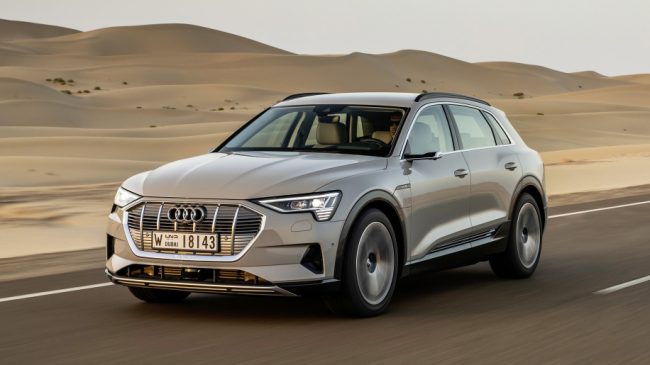The 2020 Audi E-Tron is an Audi with a battery. Depending on how much you investigate that statement, that makes the battery-electric luxury mid-sized SUV three things: boring, fascinating, and an important milestone.
Boring because the E-Tron looks and drives just like an Audi SUV. Fascinating because underneath those familiar tingles, Audi poured enormous resources into a dedicated platform that addresses the near- and long-term challenges and possibilities inherent in an EV. An important milestone because the E-Tron will be one of the first OEM luxury crossover to challenge the Goliath of the segment (you know who we’re talking about), joining the Jaguar I-Pace.
Audi slathered gobs of sound-deadening throughout the body, including behind the door panels, to obviate need for artificial noises in the cabin. Under acceleration at highway speed one hears a hint of the faintest of whines from the two electric motors. The loudest noise comes from air tumbling over the outside mirrors, a gentle rushing subtle enough to be washed away by conversation, never mind the standard, 16-speaker, 705-watt Bang & Olufsen stereo. As for using the virtual mirrors, if they’re the future, the future will take more than a day of driving to get used to.
In typical driving the electric motors provide 360 horsepower and 414 pound feet of torque, the larger 165-kW rear motor doing nearly all the work, the 135-kW front motor grabbing an oar in milliseconds when necessary.
The E-Tron rides and handles like an Audi crossover, and why not? Audi knows how to make an Audi. A skosh too much boost renders the steering light, but the typical mid-sized Audi SUV buyer wouldn’t have it any other way.
Fascinating discoveries live behind the Just Another Audi façade. The most important fact might be this: the E-Tron isn’t an electric version of an ICE car. Audi chose to pour truckloads of money and time into solving the near- and long-term challenges of an electric vehicle intended for an audience that expects OEM standards.
A thermally conductive gel spread among the pouches absorbs battery heat. The cooling system, which Audi calls the “chiller,” runs antifreeze though laminated tracks on the outside bottom of the aluminum baseplate, drawing heat out of the conductive gel in the battery through the plate. No cooling fluid enters the battery area. In a crash, assuming the vehicle stays upright, the antifreeze falls away from the battery instead of into the battery.
That chiller is one of four climate control systems monitoring the mechanicals and the passengers, with 295 switches deciding where to apply cold or warmth. By keeping the battery temperature between about 77 and 95 degrees Fahrenheit, the E-Tron maintains repeatability of performance. Audi said if you want to do time 60-mph runs, “You can do that ten times in a row, you’re always going to get 5.5 seconds,” because the battery stays in its optimal operating range.

